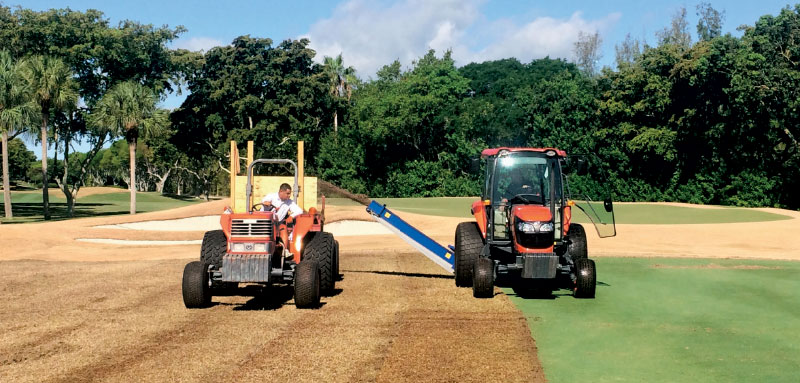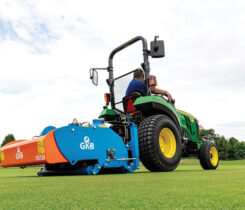Chop the top: Fraze mowing gains traction in US
Fraze mowing is becoming more popular in the U.S., and superintendents are noticing immediate results.
Ask any U.S.-based superintendent about their knowledge of, or experience with, fraze mowing and they likely will respond with a common description — unusual, shocking, perhaps even mysterious.
In fact, the concept is so new that some superintendents either haven’t heard about it or are just becoming familiar with it.
Yet, since it was introduced in 1996 by Dutch sports field manager Ko Rodenburg, it has become quite popular in the UK, especially within the soccer industry. Stadiums have used the cultural treatment technique — which removes the top ¼ inch to 2 inches of turf from fields — to eliminate most, if not all, organic buildup, Poa annua seeds and thatch.
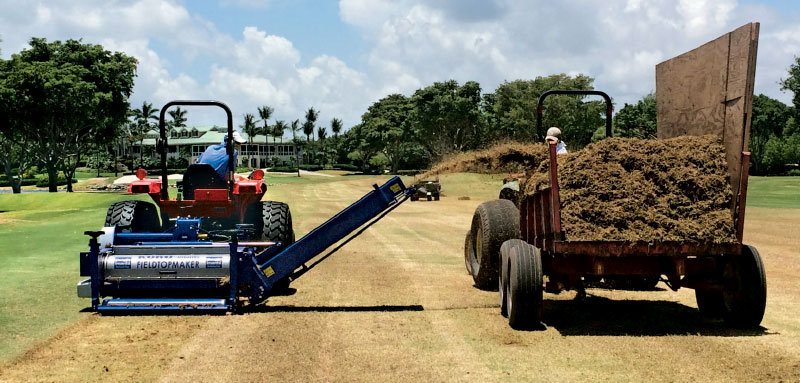 In response, the technique’s status is beginning to increase in the U.S. as well, where superintendents like Sean Anderson, who oversees the maintenance of Card Sound Golf Club, Key Largo, Fla., are discovering its positive implications firsthand.
In response, the technique’s status is beginning to increase in the U.S. as well, where superintendents like Sean Anderson, who oversees the maintenance of Card Sound Golf Club, Key Largo, Fla., are discovering its positive implications firsthand.
“In the past, we had considered ourselves aggressive in thatch management, with multiple verticuttings and aerifications performed each summer to help manage our turf,” Anderson says. “But we knew we would have a difficult time achieving our goals without stepping up our game moving forward.”
After the course’s fairways were converted during the summer of 2014 to Celebration bermudagrass, Anderson and his staff decided to implement the fraze mowing process.
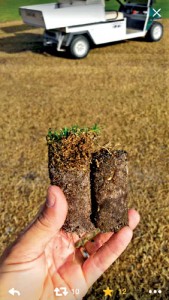 At first, they were taken aback by the results. Aside from the roots, the turf had virtually been removed, resulting in copious amounts of plant material (thatch, stolons, rhizomes, etc.) that needed to be disposed of.
At first, they were taken aback by the results. Aside from the roots, the turf had virtually been removed, resulting in copious amounts of plant material (thatch, stolons, rhizomes, etc.) that needed to be disposed of.
But then the turf began to recover. Anderson and his staff applied an initial fertilizer application right after the fraze mowing was completed. The following week, staff members began their regular foliar program, which involves spraying every other week. In less than a month, Card Sound’s fairways once again had acceptable playing surfaces without any thatch.
The ultimate thatch-eliminating practice
Anderson and his staff used a KORO Field Top Maker to complete the fraze mowing process. After attaching the Top Maker to a Kubota 5700 tractor, they simply let the machine remove the top half-inch of the fairways’ turf. All material was deposited onto a conveyor belt and then launched to the side of the tractor.
Afterward, the staff used four tractors and trailers to collect the material and transport it to an onsite area to be removed by contractors.
On the other hand, Shannon Wheeler, director of golf course maintenance at Wycliffe Golf and Country Club, Wellington, Fla., outsourced all fraze-mowing responsibilities to contractors, including the removal of turf itself.
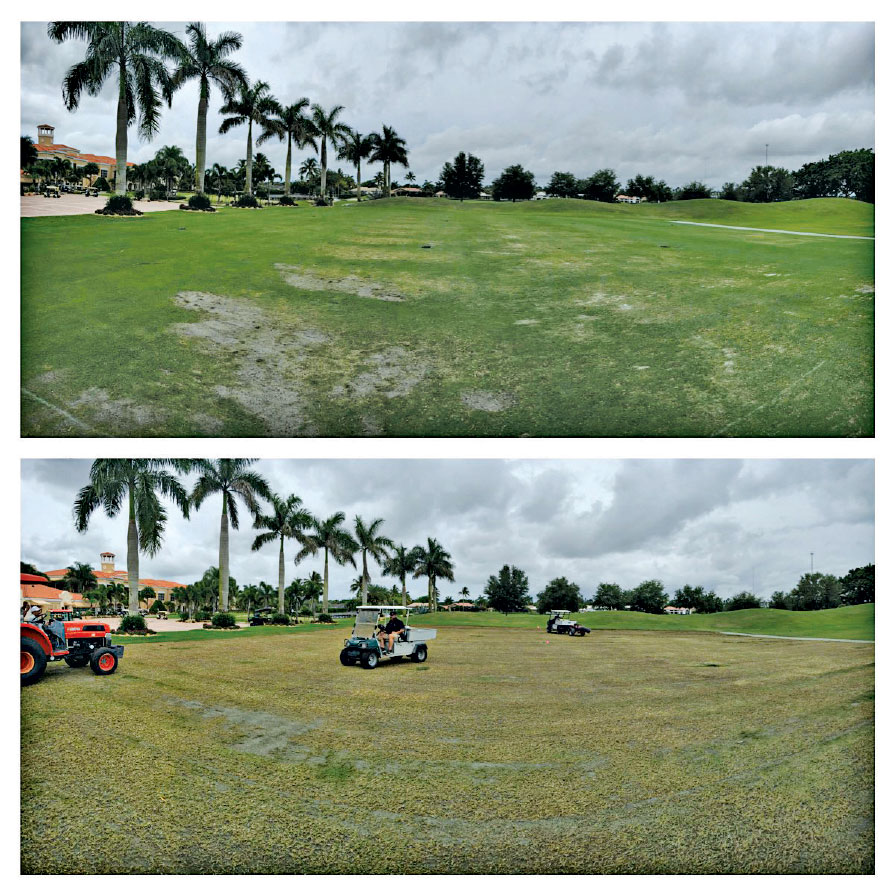 Rather than fraze mowing the course’s fairways, Wheeler decided to first focus on the Celebration bermudagrass practice range tee. Over time, the tee had become unleveled, primarily due to wear patterns from divots.
Rather than fraze mowing the course’s fairways, Wheeler decided to first focus on the Celebration bermudagrass practice range tee. Over time, the tee had become unleveled, primarily due to wear patterns from divots.
“We were interested in stripping, leveling and sodding the tee top as soon as possible,” Wheeler says. “But rather than verticutting and aerifying, we decided to try fraze mowing.”
Wheeler and his staff decided to fraze mow only half of the practice range tee this past May so course members could still use the range . Within three weeks the range was completely covered with new turf; one week later, members were able to hit balls. The process was so successful that Wheeler decided to fraze mow the other half of the tee on July 30.
“Fraze mowing provided us a less invasive and more affordable solution than regrassing,” he says. “We were able to remove the thatch layer and achieve a level surface without the added cost of stripping and leveling, since there was enough of the plant material left to regrow in an acceptable amount of time.”
The results were 1 inch of undulation removed from the practice tee and a firmer surface on which members could practice. Without the thatch, localized dry spots also declined considerably; after all, thatch decreases the durability of turf. And because Wheeler and his staff didn’t have to renovate the practice tee, the club spent only 5 percent of the cost of verticutting and aerification.
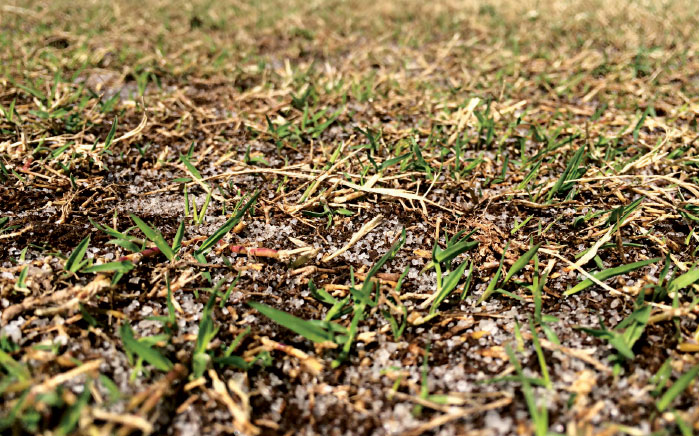 In the meantime, Anderson and his staff eliminated 95 percent of Card Sound’s thatch, all while instantly producing a grain-free surface. They also removed localized dry spots, leading to firmer fairways.
In the meantime, Anderson and his staff eliminated 95 percent of Card Sound’s thatch, all while instantly producing a grain-free surface. They also removed localized dry spots, leading to firmer fairways.
“Fraze mowing is the ultimate thatch-eliminating practice,” Anderson says. “We were practically able to regenerate brand new fairways without the headache of having to establish them from new sprigs.”
Anderson anticipates he will fraze mow again in June 2016, which will allow him to take advantage of summertime’s ideal growing conditions. In doing so, he says he will have more flexibility to be aggressive with his equipment and fraze mow as much plant material as possible.
Wheeler agrees with this time frame, believing anytime between May 1 and Aug. 15 is typically ideal.
“Superintendents should only have to fraze mow once each year,” he says. “Personally, we will reevaluate our practice range next spring to determine when we will fraze mow again. In addition, we may fraze mow the fairways of our East Course sometime in the future.”
Anderson adds, “And since every golf course is different, superintendents need to find the timing that is best for their courses, based upon experiments and, at times, trial and error.”
Advice for superintendents
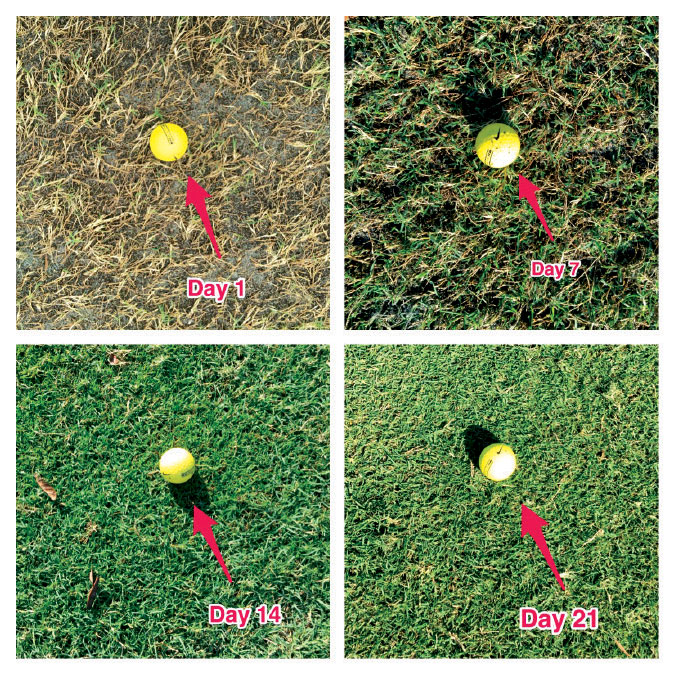 Wycliffe G&CC members were unsure about implementing the fraze mowing at the club’s practice range. So Wheeler fraze-mowed a test area two months before mowing the first half of the range. Upon realizing the benefits of the experiment, members were encouraged by the prospects of the process.
Wycliffe G&CC members were unsure about implementing the fraze mowing at the club’s practice range. So Wheeler fraze-mowed a test area two months before mowing the first half of the range. Upon realizing the benefits of the experiment, members were encouraged by the prospects of the process.
“Through proper communication and follow up, our membership was confident the process would benefit Wycliffe in the long run,” Wheeler says.
Anderson had more material to dispose of than Wheeler’s contractors, since he had chosen to fraze mow each of Card Sound’s fairways.
“The actual fraze mowing isn’t time consuming itself. However, the material collection and dumping can be,” Anderson explains. “It is important to know where the material will be disposed of, either on-site or hauled away.”
He advises superintendents to have enough trailers to transport the material without having to interrupt the fraze mowing itself. He also believes dump sites should be as close to the fairways as possible.
“If superintendents are unable to dispose of material off-site, they should consider reaching out to their local communities and seeing if someone may be able to use it, possibly for sprigs at another property or ‘fill’ material for construction,” he adds.
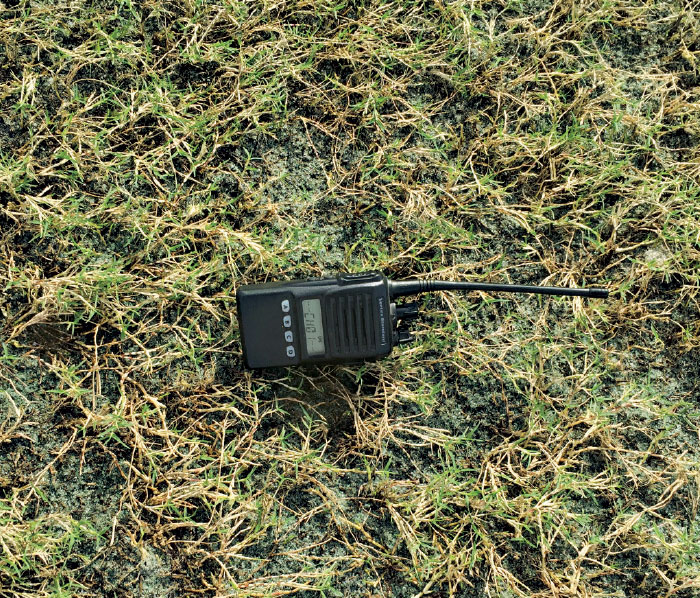 Anderson also recommends adjusting cutting depths from time to time, taking soil moisture levels and land topography into consideration.
Anderson also recommends adjusting cutting depths from time to time, taking soil moisture levels and land topography into consideration.
“One side shouldn’t be cut in deeper than another,” he says. “The adjustments are so precise too, typically anywhere from 1 to 30 millimeters, depending on the situation.”
As for the early stages of fraze mowing itself, Anderson believes patience is crucial and admits he was anxious during the first couple days of the process, especially because it removes so much turf and generates a seemingly endless amount of material needing disposal.
“You don’t need to be a hero the first day,” he states. “Remember to take it slow. It’s like a haircut. It’s always easier to cut a little more off rather than cutting too much and trying to put it back on.
Each day forward we became more comfortable with the process,” he notes, “and once we found our groove, we were able to fraze mow 3 or 4 acres a day. And now, as we look forward, we are optimistic about the ways in which the turf will perform in the future — without the thatch, seeds or buildup that had previously created a barrier between the turf and the soil.”
All photos courtesy of: Sean Anderson | Shannon Wheeler
Michigan-based writer Chris Lewis specializes in reporting on golf in the U.S. He recently wrote about 2017 U.S. Open host course Erin Hills in the April issue.






